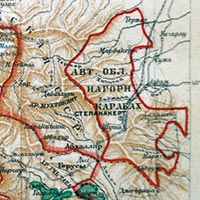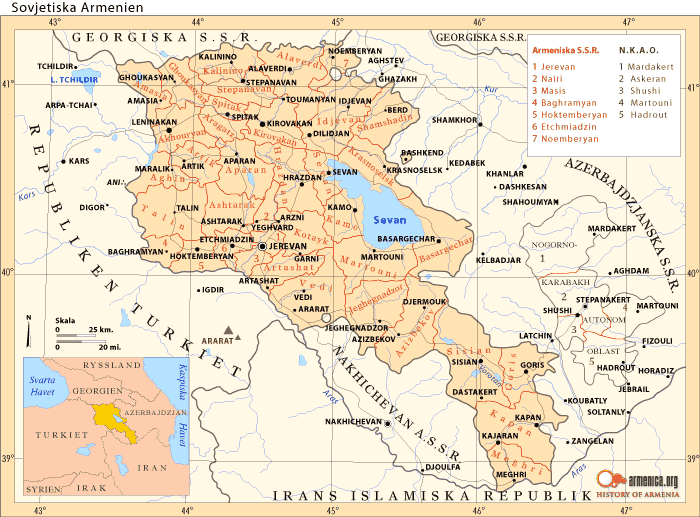|
The Sovietization of the Caucasus and Stalin's Policy of Divide and Rule
During the fall of 1920, Republic of Armenia was in a highly stressful situation. The Turkish Nationalist Army, under the leadership of Mustafa Kemal Atatürk, had resumed the offensive against Armenia, while the Red Army advanced from the east on its sovietization conquest of the Caucasus. Armenia, which after the genocide in Ottoman Turkey had been become the last refuge of the Armenian population, was facing a total annihilation. The Armenian government was faced with two choices: continue the war on two fronts against the Turks and the Bolsheviks and risk a certain destruction, or choose to capitulate to the Bolsheviks and at least probably being able to save Armenia from a Turkish extinction. However, not all Armenians were satisfied with the surrender and the general resistance to sovietization of the independent Armenia was great. In order to gain public support, the Bolsheviks promised the Armenians that they would get Karabakh as well as the disputed areas of Nakhichevan and Zangezour, both de facto belonging to Armenia (see Map 2), but claimed by now Azerbaijani SSR. This Bolshvik statement was published in fact in a statement of November 30, 1920 (the day after the proclamation of the establishment of the Armenian SSR) in which the new Soviet government in the Azerbaijani SSR declared that the regions of Nagorno-Karabakh, Nakhichevan and Zangezour were recognized as part of Soviet Armenia.[39] But soon the situation would changed to the favor of the Azeris, most notably due to the Turkish involvement. The thing wss that the Bolshevik in Moscow also had firm plans for Turkey, where they hoped that the new Republic of Turkey, under the leadership of Mustafa Kemal Ataturk and with the help from Russia, would develop into a communist rule.[40] In order to appease Turkey, the Russians chose to donate Karabakh as well as Nakhichevan, both acknowledged parts of the Republic of Armenia during 1919-1920, to Azerbaijan, the Turks' closest cousins in the Transcaucasus (Kars Treaty between Russia and Turkey, 23 October 1921). Until then, Nakhichevan had actually no common border with Turkey (see Maps 5 & 6), but Atatürk's negotiator was able to persuade Moscow to annex a narrow strip of land to Nakhichevan so that the area could have a short strip of common border (15km) with Turkey. Nakhitchevan's status could neither be able to change without Turkey's direct onsent.[41] The decision was made mainly by Joseph Stalin, the Soviet Commissar for Nationalities, is evident in the documented decision-making and the published protocols are described in more detail later in the text. The Swedish scientist Svante Cornell believes that this was a concession by Stalin against the newly formed state of Turkey due to the fact that "Atatürk was hostile to any territorial arrangements favoring Soviet Armenia, since a strong Armenia could have potential territorial claims on Turkey."[42] Stalin's involvement became apparent during the bizarre episode when Karabakh was given away to Azerbaijan. On June 12, 1921 the Communist Party Bureau in the Caucasus, brought up the issue for debate and decided that "Based on the Declaration of the Revolutionary Committee of the Socialist Soviet Republic of Azerbaijan and in accordance with the agreement between the Armenian SSR and Azerbaijan SSR, it is hereby declared that the Mountainous Karabakh from now on is part of the Armenian SSR."[43] Azerbaijan's representative at the meeting warned that the loss of Karabakh would cause anti-Soviet activities in Azerbaijan, but his statement did not affect the Commission's recommendation. The Communist Party's Bureau convened again to review the Commission's recommendations and to once and for all resolve the territorial conflicts in the Transcaucasus. On July 4, the Bureau decided, by majority vote, to transfer Karabakh to Armenian SSR. Joseph Stalin, as the Soviet Commissar for Nationalities, was also present at the meeting but took no part in the debate. We do not know the details of what Stalin said later, but after the session's ending, he has allegedly, in a closed and secret meeting, has told his opinion to the members of the Bureau in regard to the decision to transfer Nagorno-Karabakh to the Armenian SSR. The next day, without either any deliberation or any formal vote the Bureau stated the following: Thus, without giving any reason and more or less obviously on Stalin's orders, The Bureau revoked its own official majority vote verdict from the previous day and included Karabakh as an part of the Azerbaijani SSR, however, now as an autonomous enclave. The speculation are many about why Stalin insisted on the inclusion of Nagorno-Karabakh within Azerbaijan. The arguments about economic ties are regarded as reprehensible as it would mean that Nakhichevan, on the very same reasoning, would be returned to Armenia, which did not happen. The inclusion of the region in Azerbaijan would ensure peace between Armenians and Muslims (note the wording, where it did actually did not mention Azeris, but Muslims) also seems far-fetched, given both the history of the conflict and its legacy. The historian Michael P. Croissant shares the view of several other researchers who suggest that this was nothing but Stalin's policy of "divide and rule". Croissant states that, by adding the region inside Azerbaijan the Armenian population was used as a potential "hostage" in order to ensure that the Armenian SSR's cooperation with Soviet leadership was secured. Meanwhile, an "autonomous" Armenian enclave within Azerbaijan served as a potential pro-Soviet "fifth column" in the event of Azeri disloyalty.[45] In order to realize these potentials and seal their plan, on July 7, 1923, Stalin created the Autonomous Oblast (Russian province) of Nagorno-Karabakh, with its own administrative and legislative body (the Soviet), but subject to Azerbaijani SSR. This status gave the region some degree of autonomy.[46] But Stalin did not confine himself to this administrative change. At this time Karabakh bordered to Armenia and that should be taken care of (see Maps 5 & 6). The boundaries of the enclave were redrawn in such a mannert that Stalin left a narrow strip of land which physically separated Karabakh from Armenia (see Map 7). This redrawing of the borders separated Karabakh physically from the southeastern region of Zangezour in present-day Armenia. This strip was then used to create the three enclaves of Kelbadjar (Karvajar in Armenian), Latchin and Zangelan which were placed within Azerbaijani SSR, but outside of Karabakh's administrative boundaries. Even Karabakh's northern districts of Shamkhor, Khanlar, Dashkasan and Gulistan (later Shahumian), with a contemporary 90% Armenian population, were cut away from Karabakh and placed within the Azerbaijani SSR.
Similarly, Stalin gave away Nakhichevan to Azerbaijani SSR, although the area was devoid of common border with Azerbaijan and historically had always been regarded as an Armenian province. Nakhichevan came to be almost entirely emptied by its Armenian population during the Soviet era. This was achived by the socio-economic policies which the Azeri Government implemented actively in the autonomous exclave of Nakhichevan and the autonomous enclave of Nagorno-Karabakh against their Armenian populations. A census in 1979 showed that there lived 162,200 people in Karabakh, of which 123,100 (75.9%) were Armenians and 37,300 (22.9%) were Azeris.[47] The same statistics in 1923 showed that the Armenians constituted 94.4% of the population, while Azerbaijanis made up only 3% of the population. [48] This demographic change was achieved by the Azeri government through the deliberate discrimination of Armenians in order to force them away from Nakhichevan and Nagorno-Karabakh. Among other things, the government in Baku simply refused to invest any public funds in the construction and infrastructure development in Nagorno-Karabakh. Armenian schools, churches and monasteries were closed while TV and radio transmissions from Yerevan were banned. Allocated study seats at Soviet higher educational institutions were rarely granted to the population of Nagorno-Karabakh and Armenian graduates of Armenian SSR had a hard time finding work within the boundaries of Azerbaijan SSR.[49] The Karabakh conflict came to employ Soviet politicians during the entire period until the dissolution of the USSR. In a revision of the Soviet Union's Constitution in 1977, the Karabakh issue was also brought up, demonstrating the fact that the old conflict of the 1920s had never been solved or forgotten, but simply pushed aside by the governments in Baku and Moscow. The situation was apparently quite urgent and infected as early as the 1970s, when it was urgent to raise the issue at the ministerial level where it was discussed and the minutes were taken. An extract from the Council of Ministers' Protocol from November 23, 1977 is a clear demonstration of this, where the following interesting statement is recorded: However, all signs indicate that the problem was left without any action at all, either because of lack of political will or simply because they did not realize the seriousness on the issue. Within the period of ten years, the conflict would flare up again in full scale war. Notes
39) Declaration of the Azerbaijani SSR Revolutionary Committee on the recognition of Nagorno-Karabakh, Nakhichevan and Zangezour as an integral part of the Armenian SSR (unofficial translation). The recognition was published in the newspaper Communist, Yerevan, December 7, 1920. |
|



